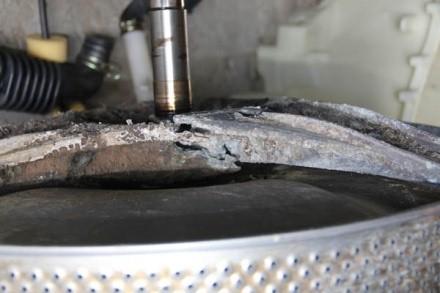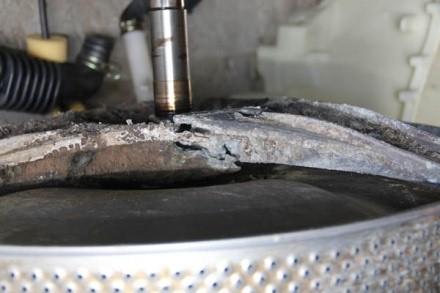The Washer Suffered from Planned Obsolescence
November 5, 2014

About nine years ago, our Maytag top-loading washer that we used for almost 20 years needed replacement. After some shopping, we decided that we would do our part for the planet by saving water and energy. We decided on a front-loading washer. We chose a stacking pair made by GE's Adora. A few weeks ago, the washer started making hideous noises during the spin cycle -- it sounded like a freight train coming through the house.
I suspected a bearing problem, but I was puzzled because at low speeds it seemed to be smooth and quiet. We hauled the machine out to the garage for a teardown and inspection. GE did not sell the bearings separately, so I knew I might have to buy a new tub. Before I did that, I decided to try getting the trade number off the bearings and see if I could install new ones myself.
When I finally got the tub halves apart, I was shocked. On the back of the basket there is a member called the spider that connects the drive shaft. This spider was made from what appeared to be aluminum or some other white metal alloy, and the spider was dissolving! One spoke had cracked and the basket was now free to wobble around inside the tub.

I am not a chemist but I remember from my chemistry classes that if you put dissimilar metals together and install them in a wet place with a high pH, you'll get corrosion. Given all the bleach and detergent you typically use in a washer, this didn't seem like a well-thought-out plan ... or was it? Could this be part of a nefarious plot to keep me buying a new washer every few years? Someone at an appliance store basically told me that these machines typically last only six to eight years and that I was lucky to get those extra years. For nine years, we used HE detergent, no liquid fabric softeners, and we kept the door open when not in use. Maybe that helped.
The spider was not available separately so I needed a new basket and spider assembly. The cost of a new part was more than half the cost of a new machine. The tub was not cracked but it had sustained a significant amount of wear from the wayward basket, so if I planned to fix the machine right, I needed a new tub as well. Add a new seal, and the cost of the repair was starting to exceed the cost of a new machine.
I did some research thinking I could buy a new machine with a better design -- perhaps an all-stainless basket, spider, and driveshaft. I was in for another surprise. The Internet is filled with horror stories of corroded and cracked spiders and not just from GE. This is a pandemic! Come on guys, I know some of you are reading this. How about a composite or even plastic? I know it would cost more, but I would like to get more than 10 years from an $800 investment. I would be willing to shell out a little extra for durability. Throw in an extended warranty on the spider and basket, a little consumer education, and you just might have a competitive advantage.
I stripped the machine and put the parts up on Craigslist but received no response. I have visions of thousands of GE Adora washers with cracked spiders sitting in landfills, so why would anyone need my parts? Does anyone know how to convert the inverter and motor to a variable speed drive? Maybe I can repurpose it and use it on my band saw. That project will have to wait for now as I am too busy rearranging and re-plumbing my utility room since the dryer won't stack on my new machine.
So how does a front loading washer actually help the planet when it only works for six to eight years before it self-destructs and turns into scrap? Did I save enough on my electricity and water over the life of this appliance to pay for what I consider a premature failure? Next time I could get an extended warranty but by coincidence, they all end at five years. Should I just go back to the classic design top loader with the agitator in the center? Speed Queen has a nice model but that will cost me more to operate; that is, until I get to year six and beyond. If this happens to you, my advice: do your homework, look at the big picture, and vote with your wallet. Caveat emptor!
Tell us your experiences with monkey-designed products. Send stories to Jennifer Campbell for Made by Monkeys.
Related posts:
About the Author(s)
You May Also Like





